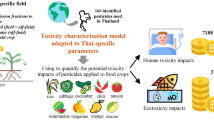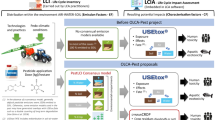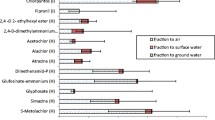Abstract
Purpose
Consumption of high quantities of pesticides in viticulture emphasizes the importance of including pesticide emissions and impacts hereof in viticulture LCAs. This paper addresses the lack of inventory models and characterization factors suited for the quantification of emissions and ecotoxicological impacts of pesticides applied to viticulture. The paper presents (i) a tailored version of PestLCI 2.0, (ii) corresponding characterization factors for freshwater ecotoxicity characterization and (iii) result comparison with other inventory approaches. The purpose of this paper is hence to present a viticulture customized version of PestLCI 2.0 and illustrate the application of this customized version on a viticulture case study.
Methods
The customization of the PestLCI 2.0 model for viticulture includes (i) addition of 29 pesticide active ingredients commonly used in vineyards, (ii) addition of 9 viticulture type specific spraying equipment and accounting the number of rows treated in one pass, and (iii) accounting for mixed canopy (vine/cover crop) pesticide interception. Applying USEtox™, the PestLCI 2.0 customization is further supported by the calculation of freshwater ecotoxicity characterization factors for active ingredients relevant for viticulture. Case studies on three different vineyard technical management routes illustrate the application of the inventory model. The inventory and freshwater ecotoxicity results are compared to two existing simplified emission modelling approaches.
Results and discussion
The assessment results show considerably different emission fractions, quantities emitted and freshwater ecotoxicity impacts between the different active ingredient applications. Three out of 21 active ingredients dominate the overall freshwater ecotoxicity: Aclonifen, Fluopicolide and Cymoxanil. The comparison with two simplified emission modelling approaches, considering field soil and air as part of the ecosphere, shows that PestLCI 2.0 yields considerable lower emissions and, consequently, lower freshwater ecotoxicity. The sensitivity analyses reveal the importance of soil and climate characteristics, canopies (vine and cover crop) development and sprayer type on the emission results. These parameters should therefore be obtained with site-specific data, while literature or generic data that are acceptable inputs for parameters whose uncertainties have less influence on the result.
Conclusions
Important specificities of viticulture have been added to the state-of-the-art inventory model PestLCI 2.0. They cover vertically trained vineyards, the most common vineyard training form; they are relevant for other perennial or bush crops provided equipment, shape of the canopy and pesticide active ingredients stay in the range of available options. A similar and compatible model is needed for inorganic pesticide active ingredients emission quantification, especially for organic viticulture impacts accounting.







Similar content being viewed by others
Notes
“Conventional” will be used in this paper to designate non-organic plant protection practices.
Technical management routes (TMRs): logical successions of technical options designed by the farmers (Renaud-Gentié et al. 2014)
Training system: type of trellis and shoot positioning resulting to a given shape of the vine canopy and position of grapes.
“Organic” is alternately used in the paper to qualify a type of crop management which uses no synthetic pesticides and a chemical type of PAIs: organic chemical compounds containing covalent bound carbon, oppositely to inorganic chemical compounds (inorganics) which do not contain carbon bound this way. Here, “organic” relates to the chemical compound nature.
USEtox™ contains no ground water compartment. Ecotoxicological impacts in freshwater from chemical emissions to groundwater are considered negligible and thus not further considered in this study.
PDOs promote and protect names of quality agricultural products and foodstuffs which are produced, processed and prepared in a given geographical area using recognized know-how (European-Commission 2014).
References
(2013) The Pesticide Properties DataBase (PPDB) developed by the Agriculture & Environment Research Unit (AERU). University-of-Hertfordshire 2006–2013
Ambiaud E (2012a) Moins de désherbants dans les vignes vol Oct 2012. Agreste, statistique agricole
Ambiaud E (2012b) Pratiques phytosanitaires dans la viticulture en 2010, SSP - Bureau des statistiques végétales et animales vol Oct 2012
Ardente F, Beccali G, Cellura M, Marvuglia A (2006) POEMS: a case study of an Italian wine-producing firm. Environ Manag 38:350–364
ATMO Drôme-Ardèche, COPARLY, SUP’AIR (2010) Suivi des pesticides dans l’air ambiant, Mesures réalisées en 2007–2008 en secteur de viticulture (69), de grandes cultures (38) et en zone péri-urbaine (07). ATMO Drôme-Ardèche, COPARLY, SUP’AIR
Aubertot J-N et al (eds) (2005) Pesticides, agriculture et environnement. Réduire l’utilisation des pesticides et en limiter les impacts environnementaux, Rapport d’Expertise scientifique collective
Benedetto G (2013) The environmental impact of a Sardinian wine by partial Life Cycle Assessment. Wine Econ Policy 2:33–41
Berghoef N, Dodds R (2013) Determinants of interest in eco-labelling in the Ontario wine industry. J Clean Prod 52:263–271
Bessou C, Basset-Mens C, Tran T, Benoist A (2012) LCA applied to perennial cropping systems: a review focused on the farm stage. Int J Life Cycle Assess 18:340–361
Birkved M, Hauschild MZ (2006) PestLCI--a model for estimating field emissions of pesticides in agricultural LCA. Ecol Model 198:433–451
Bosco S, Di Bene C, Galli M, Remorini D, Massai R, Bonari E (2011) Greenhouse gas emissions in the agricultural phase of wine production in the Maremma rural district in Tuscany, Italy. Ital J Agron 6:93–100
Brausch J, Smith P (2007) Toxicity of three polyethoxylated tallowamine surfactant formulations to laboratory and field collected fairy shrimp, thamnocephalus platyurus. Arch Environ Contam Toxicol 52:217–221
Brugière F (2009) Pratiques culturales sur vignes et pratiques oenologiques: connaissances et opinions des Français Viniflhor-Infos Vins et Cidres 160:1–10
Celen I (2010) The effect of spray mix adjuvants on spray drift. Bulg J Agric Sci 16:105–110
Christ KL, Burritt RL (2013) Critical environmental concerns in wine production: an integrative review. J Clean Prod 53:232–242
Codis S (2014) personal communication about drift measurement in viticulture and vineyard sprayers characteristics
Codis S, Bos C, Laurent S (2011) Réduction de la dérive, 8 matériels testés sur vigne. Phytoma 640:1–5
Codis S et al (2014) Une vigne artificielle pour tester la qualité de la pulvérisation. Phytoma April 2014 20–25
Dijkman T (2014) Modelling of pesticide emissions for Life Cycle Inventory analysis: model development, applications and implications. phD Thesis, Technical University of Denmark
Dijkman T, Birkved M, Hauschild M (2012) PestLCI 2.0: a second generation model for estimating emissions of pesticides from arable land in LCA. Int J Life Cycle Assess 17:973–986
Dijkman TJ, Birkved M, Hauschild MZ (2013) Fate process modelling in LCI: improving inventory quality or double counting? Paper presented at the SETAC Europe 23rd Annual Meeting, Glasgow
Dousset S, Thévenot M, Schrack D, Gouy V, Carluer N (2010) Effect of grass cover on water and pesticide transport through undisturbed soil columns, comparison with field study (Morcille watershed, Beaujolais). Environ Pollut 158:2446–2453
Ducroz F (2006) Mesures de produits phytosanitaires dans l’air en Anjou, campagne de mesures été 2006. Air Pays de Loire
European Commission Joint Research Centre IfEaS (2010) International Reference Life Cycle Data System (ILCD) handbook - general guide for life cycle assessment - detailed guidance. First edition vol EUR 24708 EN. Publications Office of the European Union, Luxembourg, doi:10.2788/38479
European-Commission (2014) Geographical indications and traditional specialities. http://ec.europa.eu/agriculture/quality/schemes/index_en.htm, Accessed 30 Jul 2014
Ganzelmeier H (2000) Drift studies and drift reducing sprayers -a german approach. Paper presented at the 2000 ASAE annual international meeting, Milwaukee, Wisconsin, July 9–12 2000
Gazulla C, Raugei M, Fullana-i-Palmer P (2010) Taking a life cycle look at crianza wine production in Spain: where are the bottlenecks? Int J Life Cycle Assess 15:330–337
Gil Y, Sinfort C, Guillaume S, Brunet Y, Palagos B (2008) Influence of micrometeorological factors on pesticide loss to the air during vine spraying: data analysis with statistical and fuzzy inference models. Biosyst Eng 100:184–197
Godard C, Boissy J, Suret C, Gabrielle B (2012) LCA of starch potato from field to starch production plant gate. Paper presented at the LCAFood 2012, 8th Int. Conference on LCA in the Agri-Food Sector, Saint Malo, 1–4 Oct 2012
Goulet E, Morlat R (2011) The use of surveys among wine growers in vineyards of the middle-Loire Valley (France), in relation to terroir studies. Land Use Policy 28:770–782
Guinee J (2002) Handbook on life cycle assessment operational guide to the ISO standards. Int J Life Cycle Assess 7:311–313
Hauschild MZ et al (2008) Building a model based on scientific consensus for life cycle impact assessment of chemicals: the search for harmony and parsimony. Environ Sci Technol 42:7032–7037
Hofstetter P (1998) Perspectives in life cycle impact assessment: a structured approach to combine models of the technosphere, ecosphere, and valuesphere. Kluwer Academic Publisher
Hugonnot O, Payet J, Maillard E (2013) AIIDA: online database for sharing and computing ecotoxicity data. Paper presented at the Avnir, Lille, France, 4–5 Nov 2013
ISO (2005) ISO 22866: 2005, Equipment for crop protection - methods for field measurement of spray drift
Jensen PK, Olesen MH (2014) Spray mass balance in pesticide application: a review. Crop Prot 61:23–31
Joliet F (2003) Une typologie du paysage de vigne pour lire sa variété: l’exemple du vignoble angevin. Rev Fr Oenol, pp 46–47
Linders J, Mensink H, Stephenson G, Wauchope D, Racke K (2000) Foliar interception and retention values after pesticide application. a proposal for standardized values for environmental risk assessment (Technical report). Pure Appl Chem 72:2199–2218
Mackie KA, Müller T, Kandeler E (2012) Remediation of copper in vineyards – a mini review. Environ Pollut 167:16–26
Mouron P, Scholz R, Nemecek T, Weber O (2006) Life cycle management on Swiss fruit farms: relating environmental and income indicators for apple-growing. Ecological Economics 58(3):561–578
Muthmann R, Nadin P (2007) The use of plant protection products in the European Union, Data 1992–2003, 2007 edn. European Commission. ISBN 92-79-03890-7
Nemecek T (2014) personnal communication about pesticide emission accounting in Ecoinvent
Nemecek T, Schnetzer J (2011) Methods of assessment of direct field emissions for LCIs of agricultural production systems, Data v3.0 (2012)
Neto B, Dias AC, Machado M (2012) Life cycle assessment of the supply chain of a Portuguese wine: from viticulture to distribution. Int J Life Cycle Assess 18:590–602
Pattara C, Raggi A, Cichelli A (2012) Life cycle assessment and carbon footprint in the wine supply-chain. Environ Manag 49:1247–1258
Petti L, Raggi A, De Camillis C, Matteucci P, Sára B, Pagliuca G, EcoLogic F (2006) Life cycle approach in an organic wine-making firm: an Italian case-study. Paper presented at the Fifth Australian Conference on Life Cycle Assessment, Melbourne, Australia, 22–24 november 2006
Point E, Tyedmers P, Naugler C (2012) Life cycle environmental impacts of wine production and consumption in Nova Scotia, Canada. J Clean Prod 27:11–20
Renaud C, Benoît M, Jourjon F (2012) An approach for evaluation of compatibility between grape quality and environmental objectives in Loire valley PDO wine production Bull OIV 85 (N° 977-978-979) 339–346
Renaud-Gentié C, Burgos S, Benoît M (2014) Choosing the most representative technical management routes within diverse management practices: application to vineyards in the Loire Valley for environmental and quality assessment. Eur J Agron 56:19–36
Rosenbaum R et al (2008) USEtox—the UNEP-SETAC toxicity model: recommended characterisation factors for human toxicity and freshwater ecotoxicity in life cycle impact assessment. Int J Life Cycle Assess 13:532–546
Sinfort C (2014) personal communication about interception of spray mixture by vineyard and grass cover at different stages of vine growth
Sinfort C, Cotteux E, Bonicelli B, Ruelle B (2009) Une méthodologie pour évaluer les pertes de pesticides vers l’environnement pendant les pulvérisations viticoles. Paper presented at the STIC & Environnement, Calais, France, 2009
Tonietto J, Carbonneau A (2004) A multicriteria climatic classification system for grape-growing regions worldwide. Agric For Meteorol 124:81–97
US-Environmental-protection-Agency (2012) EPI SuiteTM v4.11. US Environmental protection agency
van Zelm R, Huijbregts MJ, van de Meent D (2009) USES-LCA 2.0—a global nested multi-media fate, exposure, and effects model. Int J Life Cycle Assess 14:282–284
van Zelm R, Larrey-Lassalle P, Roux P (2014) Bridging the gap between life cycle inventory and impact assessment for toxicological assessments of pesticides used in crop production. Chemosphere 100:175–181
Vázquez-Rowe I, Villanueva-Rey P, Moreira MT, Feijoo G (2012) Environmental analysis of Ribeiro wine from a timeline perspective: harvest year matters when reporting environmental impacts. J Environ Manag 98:73–83
Villanueva-Rey P, Vázquez-Rowe I, Moreira MT, Feijoo G (2014) Comparative life cycle assessment in the wine sector: biodynamic vs. conventional viticulture activities in NW Spain. J Clean Prod 65:330–341
Acknowledgments
The authors thank Interloire and Region pays de la Loire for funding, the winegrowers for their time and data, MM. E. Bezuidenhoud, C. Renaud, A. Rouault, Miss D. Boudiaf and S. Beauchet for their help in data collection, Mrs C. Sinfort and M. S Codis for their results communication, Mr T. Nemecek for answering our questions about Ecoinvent, Mr M. Benoît for his core reading and Mrs F. Jourjon for her advices. The authors thank the four anonymous reviewers for their contribution to the improvement of the paper.
Author information
Authors and Affiliations
Corresponding author
Additional information
Responsible editor: Michael Z. Hauschild
Electronic supplementary material
Below is the link to the electronic supplementary material.
ESM 1
(DOCX 2250 kb)
Rights and permissions
About this article
Cite this article
Renaud-Gentié, C., Dijkman, T.J., Bjørn, A. et al. Pesticide emission modelling and freshwater ecotoxicity assessment for Grapevine LCA: adaptation of PestLCI 2.0 to viticulture. Int J Life Cycle Assess 20, 1528–1543 (2015). https://doi.org/10.1007/s11367-015-0949-9
Received:
Accepted:
Published:
Issue Date:
DOI: https://doi.org/10.1007/s11367-015-0949-9




